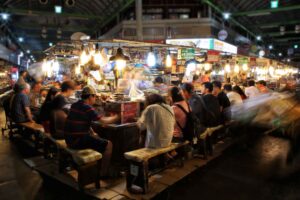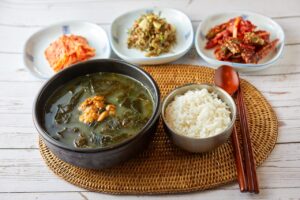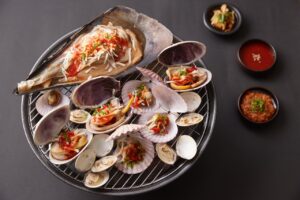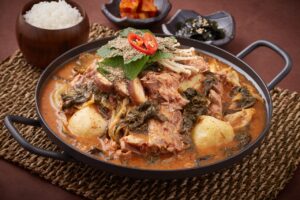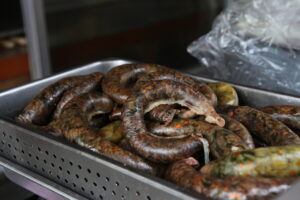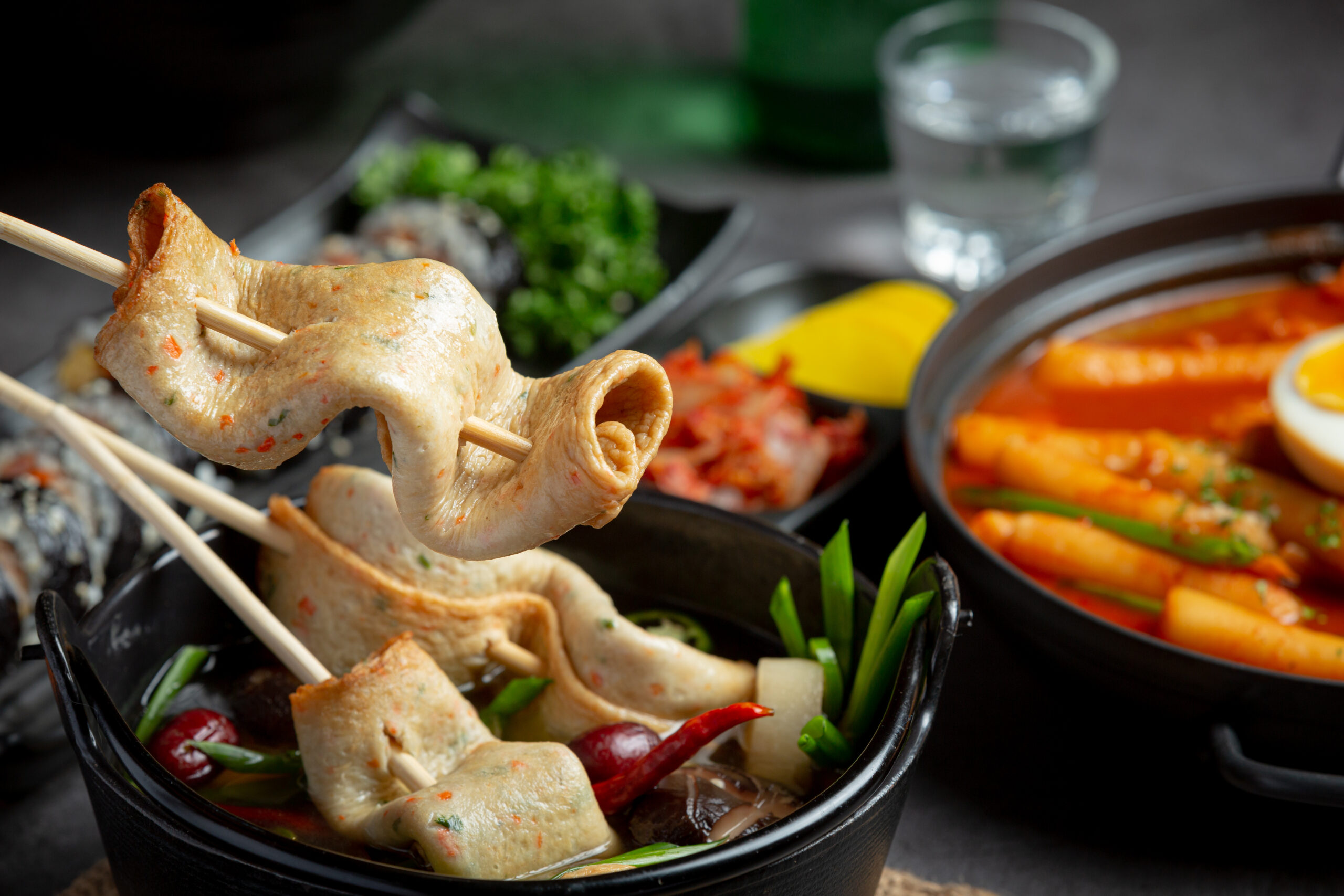
Korean fish cake and vegetable soup on table
Odeng (오뎅), also known as eomuk (어묵), is a popular Korean street food that consists of skewered fish cakes that are typically boiled or steamed and served in a warm and savory broth. It is beloved by locals and visitors alike for its comforting taste and affordability. It’s a quintessential street food that can be found in various locations across Korea. Here’s more information about this famous Korean snack:
Ingredients and Preparation:
Ingredients and Preparation:
- Fish Cake: It is made from fish paste that is seasoned with various ingredients like starch, salt, and sometimes other flavorings. The fish paste is then shaped into various forms, such as cylinders, ovals, or even intricate designs.
- Skewering: The fish cakes are skewered onto wooden sticks or skewers, making them easy to eat and carry.
- Boiling or Steaming: The skewered fish cakes are then boiled or steamed until they are fully cooked. This process gives them a bouncy and slightly chewy texture.
Serving: It is typically served on the skewers in a warm and savory broth. The broth is often made from a base of anchovy and kelp stock, which infuses the fish cakes with additional flavor. The fish cakes absorb the flavors of the broth, creating a delicious and satisfying snack.
Dipping Sauce: It is often served with a dipping sauce, which is usually a mixture of soy sauce, sesame oil, and sometimes a touch of spicy gochugaru (red pepper flakes). Dipping the fish cakes in the sauce adds an extra layer of flavor and enhances the overall experience.
Variations and Availability:
- Tteokbokki Odeng: In some places, you can find odeng served with tteokbokki sauce, which is a spicy and sweet red pepper sauce often associated with another popular Korean street food, tteokbokki (spicy rice cakes).
- Eomuk Bokkeum: Eomuk bokkeum is a stir-fried version of fish cakes that are cooked with vegetables and a flavorful sauce. It’s a popular side dish often enjoyed with rice.
Cultural Significance: It holds cultural significance in Korea as a nostalgic and comforting street food that’s been enjoyed for generations. It’s often associated with cold weather and served as a warm and satisfying snack to ward off the chill.
Availability: It can be found at street food stalls, markets, and even in convenience stores throughout Korea. It’s a popular snack that’s enjoyed by people of all ages and backgrounds.
Odeng as a Symbol: Odeng’s affordability, accessibility, and heartwarming qualities have turned it into a cultural symbol of Korean street food culture, representing the simple joys of snacking and communal eating in Korea.
Famous place for Odeng in Busan
- Jagalchi Fish Market (자갈치시장): As Busan’s most famous fish market, Jagalchi Market is a prime destination to try fresh seafood, including odeng. You’ll find numerous vendors offering a variety of fish cake skewers. The market is also a cultural experience as you can see a wide range of seafood on display.
- Bupyeong Kkangtong Market (부평깡통시장): This traditional market is known for its vibrant atmosphere and diverse food offerings. You’ll find a variety of food stalls selling odeng and other street foods.
- Gukje Market (국제시장): Gukje Market is one of the largest markets in Busan, offering an array of goods and foods. You can explore the market’s alleys and find stalls selling odeng, along with other local treats.
- Haeundae Beach Area: Near Haeundae Beach, especially during the summer months, you might find street vendors selling odeng along the beach promenade. It’s a great opportunity to enjoy the sea breeze and delicious street food.
- Seomyeon Food Street: Seomyeon is a bustling commercial district in Busan with a variety of restaurants and street food stalls. You’re likely to come across odeng vendors in this area.
- Busan Station Area: The area around Busan Station is another spot where you might find odeng stalls, especially catering to commuters and travelers.
- Taejongdae Park: If you’re visiting Taejongdae Park, a scenic coastal park in Busan, you might find odeng stalls near the entrance or within the park.
Remember that Busan’s street food scene is lively and dynamic, so you might discover odeng stalls in unexpected places as well. Don’t hesitate to explore different areas of the city and try this popular Korean street food.
Recommend Cooking Method with Odeng
“Odeng” (어묵) is a popular Korean street food made from fish cake skewers that are typically served in a warm and savory broth. Fish cake skewers are commonly enjoyed by Koreans as a quick and satisfying snack. Here’s how odeng is typically prepared and cooked:
Ingredients:
- Fish cake skewers (odeng)
- Broth or soup base (often made from dashi or anchovy stock)
- Soy sauce
- Sugar
- Mirin (rice wine for cooking)
- Optional toppings (such as green onions, sesame seeds, or sesame oil)
Cooking Method:
- Prepare the Broth:
- In a pot, prepare a broth or soup base. This can be made using dashi (Japanese stock) or anchovy stock. The broth provides the flavorful base for cooking and serving the odeng skewers.
- Season the Broth:
- Season the broth with soy sauce, sugar, and mirin to achieve a savory-sweet flavor profile. The exact quantities of these ingredients can be adjusted to taste.
- Simmer the Broth:
- Heat the seasoned broth on the stovetop and bring it to a gentle simmer. This will allow the flavors to meld together.
- Add the Odeng Skewers:
- Place the fish cake skewers (odeng) into the simmering broth. The skewers are typically made from processed fish cake mixture that has been molded onto sticks.
- Cooking and Absorption:
- Allow the odeng skewers to simmer in the broth until they are heated through and have absorbed some of the flavors from the broth.
- Serving:
- Once the odeng skewers are heated and have absorbed the flavors, they are ready to be served. They are often served directly from the pot of broth, allowing the skewers to stay warm.
- Optional Toppings:
- Odeng can be enjoyed with optional toppings such as chopped green onions, sesame seeds, and a drizzle of sesame oil. These toppings enhance the flavor and presentation of the dish.
- Sipping the Broth:
- The warm and savory broth in which the odeng is cooked is also an integral part of the experience. It’s common to sip the broth between bites of the fish cake skewers for a comforting and flavorful treat.
Odeng is a popular street food that can be found at various food stalls, markets, and convenience stores in South Korea. The cooking method described above showcases the traditional way of preparing and serving odeng, offering a tasty and comforting snack for people on the go.
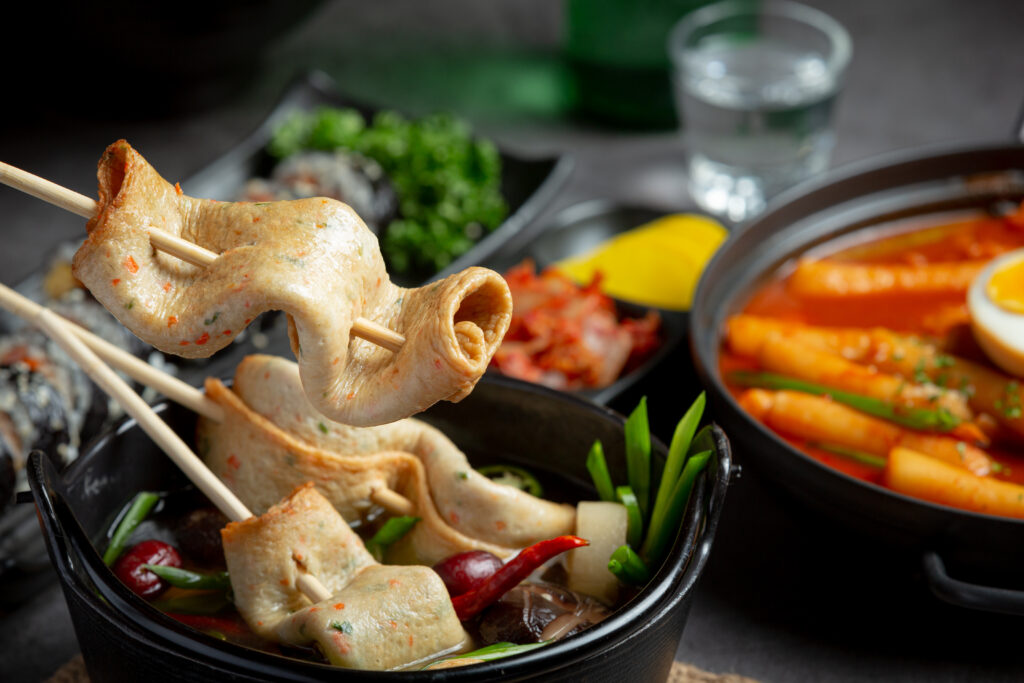
…
…
…
Recommend to read >>>
Samgyetang(삼계탕) for summer #1 health in korea
